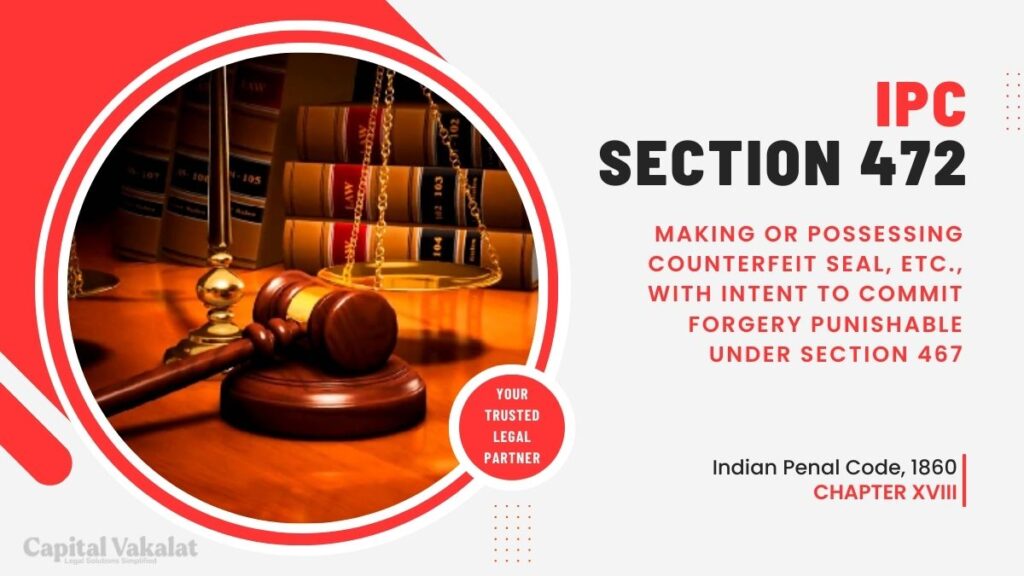Forgery is a crime that has evolved over the years, and legal systems worldwide constantly adapt to address new challenges. In India, Section 472 of the Indian Penal Code (IPC) plays a crucial role in combating forgery by specifically targeting the making or possessing of counterfeit seals with the intent to commit forgery, punishable under Section 467.

This article explores the nuances of Section 472 IPC, delving into the legal aspects, historical context, and its significance in the modern era.
Introduction to Section 472 IPC
Forgery is a serious offense, and Section 472 of the IPC takes a firm stance against activities involving counterfeit seals. The section explicitly deals with the act of making or possessing such counterfeit seals, emphasizing the importance of intent to commit forgery. Understanding the intricacies of this section is essential for legal professionals, policymakers, and the general public.
Understanding Counterfeit Seals
Counterfeit seals come in various forms and can be used for nefarious purposes. From fake corporate stamps to forged official emblems, these counterfeit seals can be challenging to detect. This section explores the different types of counterfeit seals, providing examples to illustrate their real-world implications.
Intent to Commit Forgery
One of the key elements of Section 472 IPC is the presence of intent to commit forgery. Exploring this aspect sheds light on the mental state required for an individual to be charged under this section. The article discusses the legal consequences associated with proving intent, emphasizing its role in the judicial process.
Punishments under Section 467
To comprehend the gravity of offenses related to counterfeit seals, it is essential to delve into Section 467 of the IPC. This section outlines the punishments for forgery, emphasizing the severity of consequences for those found guilty. Understanding these penalties provides insight into the deterrence aspect of the legal framework.
Historical Context
Forgery has a rich history, and laws related to counterfeit activities have evolved over time. This section explores the historical context of forgery laws in India, examining how they have changed and adapted to address emerging challenges. Notable cases and their impact on legislation are also discussed.
Significance in Modern Society
As society becomes more complex, so do the methods employed by those engaged in forgery. Section 472 IPC remains relevant in addressing contemporary challenges posed by technological advancements. This section of the article highlights recent examples of counterfeit activities and their consequences, emphasizing the ongoing need for robust legal frameworks.
The Burden of Proof
Legal proceedings related to Section 472 IPC require a thorough examination of evidence. This section discusses the burden of proof in cases involving counterfeit seals, exploring the challenges faced by both the prosecution and defense. An understanding of this aspect is crucial for legal practitioners involved in such cases.
Legal Defenses
Individuals accused under Section 472 IPC may employ various defenses to challenge the charges. This section outlines common defenses against allegations of making or possessing counterfeit seals. Case law examples are provided to illustrate instances where these defenses have been successful.
International Perspective
Forgery is not limited to national borders, and a comparative analysis of similar laws globally provides a broader perspective. This section explores how different jurisdictions approach offenses related to counterfeit seals. The discussion also includes aspects of international cooperation and extradition in cases of cross-border forgery.
Compliance and Prevention
Preventing forgery requires a proactive approach from individuals and businesses. This section offers insights into measures that can be taken to comply with Section 472 IPC. Additionally, the role of technology in preventing counterfeit activities is explored, highlighting advancements that contribute to a more secure environment.
Conclusion
In conclusion, Section 472 IPC plays a pivotal role in addressing the intricate issue of making or possessing counterfeit seals with the intent to commit forgery. By understanding the legal nuances, historical context, and contemporary significance, stakeholders can contribute to a legal framework that effectively combats forgery.
Frequently Asked Questions
How does technology contribute to preventing counterfeit activities under Section 472?
Technology, such as digital authentication methods, can enhance the security of seals and documents, making forgery more challenging.
Can a person be charged under both Section 472 and Section 467 IPC simultaneously?
Yes, if the individual is found to have made or possessed counterfeit seals with the intent to commit forgery, charges under both sections may apply.
What defenses can be used against charges under Section 472 IPC?
Common defenses include lack of intent, mistaken identity, and improper handling of evidence. Each case is unique, and defenses may vary.
How can businesses ensure compliance with Section 472 IPC in their operations?
Businesses can implement robust internal controls, document verification processes, and employee training programs to prevent inadvertent involvement in counterfeit activities.